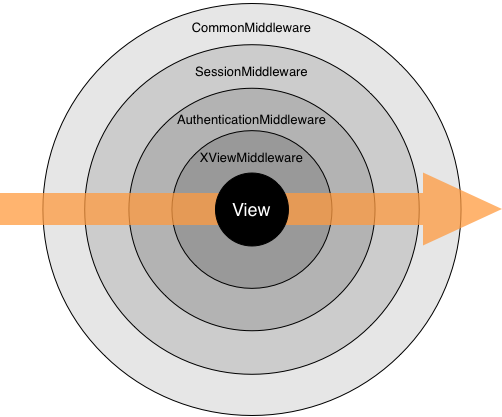Middleware¶
Middleware is a framework of hooks into Django’s request/response processing. It’s a light, low-level “plugin” system for globally altering Django’s input and/or output.
Each middleware component is responsible for doing some specific function. For example, Django includes a middleware component, XViewMiddleware, that adds an "X-View" HTTP header to every response to a HEAD request.
This document explains how middleware works, how you activate middleware, and how to write your own middleware. Django ships with some built-in middleware you can use right out of the box; they’re documented in the built-in middleware reference.
Activating middleware¶
To activate a middleware component, add it to the MIDDLEWARE_CLASSES list in your Django settings. In MIDDLEWARE_CLASSES, each middleware component is represented by a string: the full Python path to the middleware’s class name. For example, here’s the default MIDDLEWARE_CLASSES created by django-admin.py startproject:
MIDDLEWARE_CLASSES = (
'django.middleware.common.CommonMiddleware',
'django.contrib.sessions.middleware.SessionMiddleware',
'django.contrib.auth.middleware.AuthenticationMiddleware',
)
During the request phases (process_request() and process_view() middleware), Django applies middleware in the order it's defined in MIDDLEWARE_CLASSES, top-down. During the response phases (process_response() and process_exception() middleware), the classes are applied in reverse order, from the bottom up. You can think of it like an onion: each middleware class is a "layer" that wraps the view:

A Django installation doesn't require any middleware -- e.g., MIDDLEWARE_CLASSES can be empty, if you'd like -- but it's strongly suggested that you at least use CommonMiddleware.
Writing your own middleware¶
Writing your own middleware is easy. Each middleware component is a single Python class that defines one or more of the following methods:
process_request¶
- process_request(self, request)¶
request is an HttpRequest object. This method is called on each request, before Django decides which view to execute.
process_request() should return either None or an HttpResponse object. If it returns None, Django will continue processing this request, executing any other middleware and, then, the appropriate view. If it returns an HttpResponse object, Django won't bother calling ANY other request, view or exception middleware, or the appropriate view; it'll return that HttpResponse. Response middleware is always called on every response.
process_view¶
- process_view(self, request, view_func, view_args, view_kwargs)¶
request is an HttpRequest object. view_func is the Python function that Django is about to use. (It's the actual function object, not the name of the function as a string.) view_args is a list of positional arguments that will be passed to the view, and view_kwargs is a dictionary of keyword arguments that will be passed to the view. Neither view_args nor view_kwargs include the first view argument (request).
process_view() is called just before Django calls the view. It should return either None or an HttpResponse object. If it returns None, Django will continue processing this request, executing any other process_view() middleware and, then, the appropriate view. If it returns an HttpResponse object, Django won't bother calling ANY other request, view or exception middleware, or the appropriate view; it'll return that HttpResponse. Response middleware is always called on every response.
process_response¶
- process_response(self, request, response)¶
request is an HttpRequest object. response is the HttpResponse object returned by a Django view.
process_response() must return an HttpResponse object. It could alter the given response, or it could create and return a brand-new HttpResponse.
Unlike the process_request() and process_view() methods, the process_response() method is always called, even if the process_request() and process_view() methods of the same middleware class were skipped because an earlier middleware method returned an HttpResponse (this means that your process_response() method cannot rely on setup done in process_request(), for example). In addition, during the response phase the classes are applied in reverse order, from the bottom up. This means classes defined at the end of MIDDLEWARE_CLASSES will be run first.
process_exception¶
- process_exception(self, request, exception)¶
request is an HttpRequest object. exception is an Exception object raised by the view function.
Django calls process_exception() when a view raises an exception. process_exception() should return either None or an HttpResponse object. If it returns an HttpResponse object, the response will be returned to the browser. Otherwise, default exception handling kicks in.
Again, middleware are run in reverse order during the response phase, which includes process_exception. If an exception middleware return a response, the middleware classes above that middleware will not be called at all.
__init__¶
Most middleware classes won't need an initializer since middleware classes are essentially placeholders for the process_* methods. If you do need some global state you may use __init__ to set up. However, keep in mind a couple of caveats:
- Django initializes your middleware without any arguments, so you can't define __init__ as requiring any arguments.
- Unlike the process_* methods which get called once per request, __init__ gets called only once, when the web server starts up.
Marking middleware as unused¶
It's sometimes useful to determine at run-time whether a piece of middleware should be used. In these cases, your middleware's __init__ method may raise django.core.exceptions.MiddlewareNotUsed. Django will then remove that piece of middleware from the middleware process.
Guidelines¶
- Middleware classes don't have to subclass anything.
- The middleware class can live anywhere on your Python path. All Django cares about is that the MIDDLEWARE_CLASSES setting includes the path to it.
- Feel free to look at Django's available middleware for examples.
- If you write a middleware component that you think would be useful to other people, contribute to the community! Let us know, and we'll consider adding it to Django.
Last update:
Sep 20, 2009